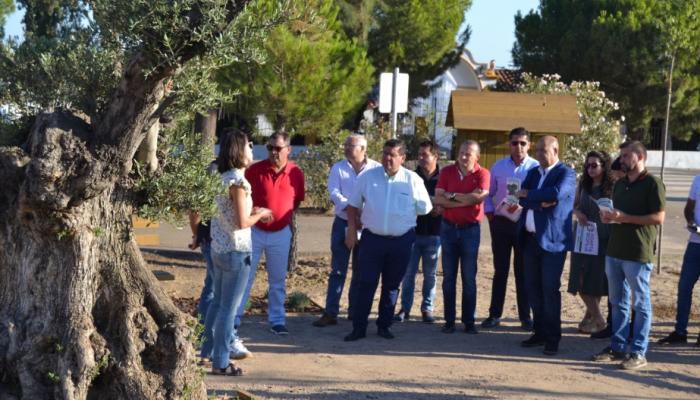
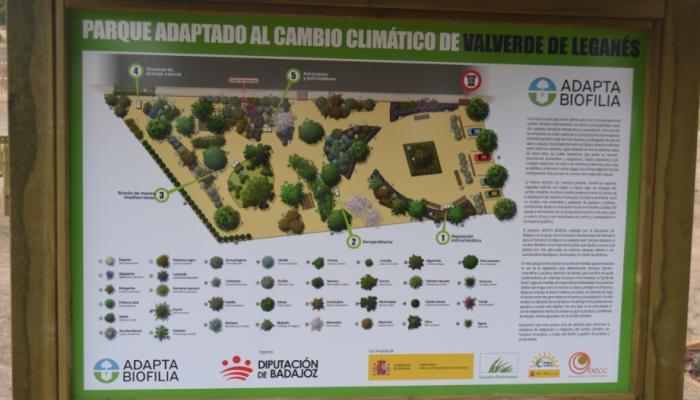
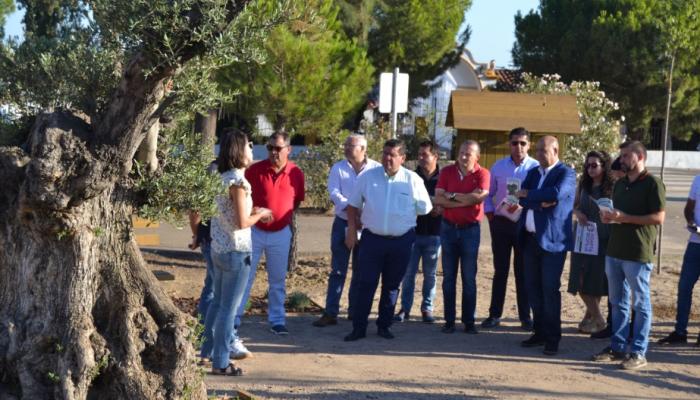
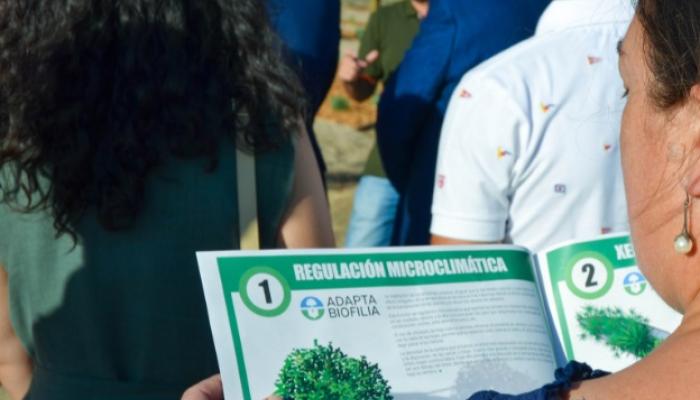
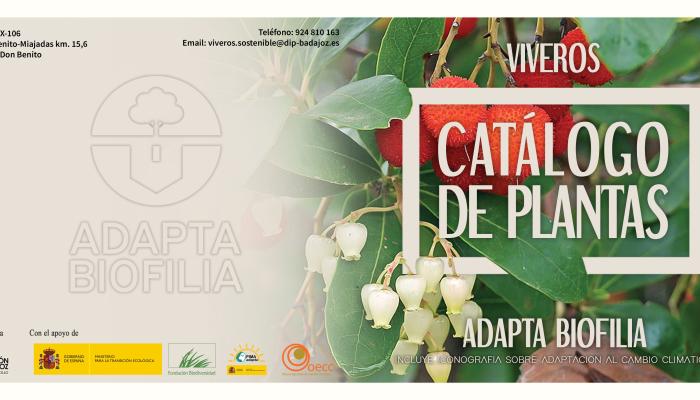
Adapta BIOFILIA is a local climate change adaptation project developed by the Provincial Council of Badajoz, focusing particularly on plant biodiversity and the role that municipal green areas can play in enhancing the adaptive capacity of municipalities across the province in the face of climate vulnerability.
The project aims to improve the public service provided to these municipalities through the Provincial Council’s Nursery in Badajoz, by defining a new catalogue of plant species that incorporates climate adaptation criteria into the species offered. This is being developed in collaboration with the Provincial Council of Huelva’s nursery, and includes the design of a model garden in Valverde de Leganés, which will serve as a replicable prototype for both provinces, given their very similar climatic conditions.
Given the projected climate change scenario in Extremadura, with an expected temperature increase that could exceed 3 °C, and considering the region’s geographic characteristics—including an ageing population in many small municipalities that are especially vulnerable to thermal changes and extreme events such as heat waves—it is essential to integrate adaptation measures that enable better prevention and preparedness.
At the same time, it is well established that urban vegetation contributes both to enhancing the adaptive capacity of municipalities to climate change and to reducing the vulnerability of the most sensitive population groups to its effects—for instance, through the shade provided by trees during heat waves. Moreover, vegetation also plays a key role in mitigating climate change by absorbing greenhouse gases.
In this regard, trees and green areas in municipalities perform numerous functions related to climate change, as the greater the extent of green infrastructure in urban environments, the greater its contribution to climate adaptation and mitigation.
- Greater adaptive capacity to the expected effects of climate change — for example, in the case of torrential rains and/or floods — as trees intercept rainfall through their canopies and absorb water through their roots, thereby reducing pressure on drainage networks and contributing to groundwater recharge. In addition, tree roots play an important role in water purification.
- Reduced climatic vulnerability of the municipality.
- Lower exposure of people to extreme events such as heat waves, as trees provide extensive shaded areas within urban environments.
- Improved well-being and quality of life, with enhanced overall thermal comfort.
- Increased capacity to absorb greenhouse gases and air pollutants, including CO₂, NOₓ, SOₓ, and other volatile organic compounds (VOCs).
- Enhanced ability to capture dust and particulates, along with an increase in atmospheric oxygen levels.
- Higher ambient humidity, generating a cooling effect.
- Greater protection against wind due to the barrier effect of trees (with medium densities being the most effective).
- Improved acoustic comfort, through noise reduction provided by vegetation.
- Reduced economic losses, resulting from resource savings and lower energy expenditure.
On the other hand, both in cities and in smaller municipalities it is also necessary to:
- Promoting biodiversity in parks and gardens, as well as fostering more ecological management practices in these landscaped spaces. The greater the structural complexity and biodiversity of urban green areas, the wider the range of animal species they can support — from invertebrates and birds to larger predators. In addition, prioritizing native plant species over exotic ones favors the proliferation of endemic fauna.
- Preserving and efficiently managing limited water resources, by selecting plant species with low irrigation requirements and implementing efficient watering systems.
- Addressing the deficit of contact with nature among the elderly and children — known as “nature deficit disorder” — which can lead to deficiencies in motor, sensory, psychological, and cognitive development.
- Urban green infrastructure therefore plays a dual role in relation to climate change: on the one hand, it contributes to mitigation by acting as a carbon sink, and on the other, it serves as an adaptation measure that enhances resilience to climate impacts.
- This underscores the need to adopt the concept of “Urban Green Infrastructure Plans” rather than simply referring to “municipal green areas,” as it implies the necessity of prior planning and the recognition of green spaces as essential infrastructure for both urban development and public well-being.
- Ultimately, this calls for municipalities to evolve towards truly biophilic spaces, where appropriate species selection, efficient irrigation and soil management techniques, and careful pruning and maintenance of urban trees are integrated into everyday planning and management.
Through the Adapta BIOFILIA project, the nursery services of the Provincial Council of Badajoz are being enhanced by integrating climate change adaptation criteria into the selection, production, and supply of plants. The project focuses specifically on species best suited to emerging climatic conditions and includes the development of a replicable model garden or park, while also strengthening climate governance across the province.
The overarching goal is to maintain and enhance the resilience of ecosystems and communities, while reducing their vulnerability to the adverse effects of climate change.
With this general approach:
- A study and review of the current plant species supplied by the Provincial Council has been carried out, identifying alternative species better adapted to projected climatic changes under different regionalized climate scenarios for Extremadura. This will enable the gradual introduction and production of better-adapted species in municipal nurseries.
- Awareness-raising efforts have also been undertaken among municipal managers and technical staff in the fields of urban planning and landscaping, encouraging them to integrate climate adaptation criteria when requesting plants from municipal nurseries.
the first garden adapted to climate change in Extremadura, located in Valverde de Leganés, has been launched as a pilot project of "adapted green space" for replication in other municipalities of Badajoz and Huelva. This garden features:
- Plant species capable of withstanding the effects of climate change, particularly those adapted to severe summer drought conditions.
- Species with low or minimal water requirements.
- An efficient, low-maintenance irrigation system.
- Training and capacity-building activities have been carried out on best practices in sustainable gardening for both nursery staff and municipal horticultural technicians and professionals in the sector, to ensure that climate change adaptation and mitigation are integrated into their daily work.
- During the project, a Network of Climate Change and Green Area Agents was also established, comprising individuals from diverse disciplines, professional backgrounds, and levels of training. This network has facilitated the dissemination and exchange of knowledge, actions, and experiences in the design, creation, and maintenance of gardens adapted to climate change.
In order to achieve these objectives, the Adapta BIOFILIA project carried out the following actions:
- Comparative study of existing vegetation versus potential vegetation for climate change adaptation — from provincial nurseries to municipal implementation.
- Development of an updated joint catalogue of plant species from the nurseries of the Provincial Councils of Badajoz and Huelva, designed from the perspective of climate change adaptation, accompanied by an informative brochure that includes an “adaptability” iconography for each species, taking into account the following parameters:
drought resistance
Frost resistance
Resistance to contamination
Resistance to pests and diseases
- Pilot experience: design of a model garden/park in Valverde de Leganés, conceived as a “green space for replicable climate adaptation” in municipalities across the provinces of Badajoz and Huelva
Training, communication and awareness-raising actions: training course on local adaptation and mitigation to climate change through vegetation, informative and awareness-raising day for "decision-makers", municipal politicians and technicians and environmental communication, content marketing and replicability.
The ADAPTA BIOPHILIA project offers solutions based on “green measures,” which harness the multiple services and functions of ecosystems and nature to help society adapt to the impacts of climate change.
In this regard, the implementation of green adaptation actions provides a dual benefit:
- Increase the adaptive capacity of municipalities by reducing the effects of heat waves on vulnerable populations and lowering the incidence of pests.
- They also have a mitigating effect, as plants act as sinks for pollutants and greenhouse gases, thereby improving air quality.
All of this contributes to a reduction in economic losses and costs associated with the unnecessary consumption of resources, as well as to the improvement of health and quality of life for residents—particularly the most vulnerable groups.
The project has proposed practical solutions, such as the new Plant Catalogue of the Provincial Nursery, which supports the selection of species better adapted to local climatic conditions. The catalogue provides detailed information on each species through descriptive data sheets outlining their physiological and functional characteristics, while also considering aesthetic qualities. It includes information on drought, frost, pollution, pest, and disease resistance, as well as potential allergenic or toxic properties, all presented through a clear iconographic system illustrating climate adaptation capacity.
In the pilot garden model developed, a range of demonstrative measures have been implemented to showcase the use of vegetation for multiple ecosystem services—including windbreak and acoustic barriers, slope stabilization, and shade provision for pollinators. In addition, the garden features a “rain garden” and biodiversity enhancement measures, as well as efficient irrigation systems that serve as visible examples of good practice and key tools for adaptation.
Both the new plant catalogue and the pilot garden offer practical, replicable solutions to begin the path toward climate change adaptation and mitigation in the municipalities of the province of Badajoz, through the design, planning, and management of sustainable gardens and green areas.
The development of this project takes into account the specific characteristics of rural areas. In this sense, adapting the “green infrastructure” of these municipalities is essential for climate change adaptation, prevention, and impact reduction, particularly in view of the different climate scenarios projected for Extremadura. The selection of appropriate plant species for the design of municipal green areas and gardens contributes to creating more rational, cost-effective, and climate-resilient spaces, improving thermal comfort and environmental quality in urban centers across the region.
Municipal managers, technical staff, and local gardeners now have practical tools to help them plan and manage urban green infrastructure objectively and effectively, enabling them to respond more efficiently to the challenges of climate change.
With the implementation of the measures developed under the project, the public nursery service of the Badajoz Provincial Council will be strengthened through the supply of plant species better adapted to local climatic conditions, systematically incorporating climate change adaptation criteria into its operations. This will generate valuable knowledge on the species best suited to future climate scenarios and enable the development of an adapted and optimized garden/park model, while also contributing to improved climate governance at the local level.
Until now, the provincial nursery service had not explicitly incorporated climate change adaptation and mitigation criteria into its plant selection process—although it already considered the inclusion of native, naturalized, and non-native species. The introduction of adaptation criteria will now be integrated into the botanical classification of nursery species, ensuring their systematic use in the selection and supply of plants for municipal parks and gardens. This will promote the preferential use of species best adapted to the climatic conditions expected in Extremadura over the medium and long term.
Through this project, awareness and capacity-building among local representatives and urban landscaping technicians are also being promoted, encouraging them to apply the climate adaptation criterion when requesting plants from municipal nurseries. In this regard, the new plant catalogue, featuring iconography related to adaptation to climate change, will serve as a practical tool to guide informed and selective plant choice.
In addition, a prototype “model garden” has been developed as a replicable example for other municipalities. This model goes beyond the botanical dimension, integrating additional measures for efficient water use, sustainable drainage systems, and other variables subject to study and monitoring.
Of particular importance is the optimization and sustainable management of water resources addressed by the project, through the implementation of efficient irrigation systems and the promotion of a more integrated social and urban understanding of the water cycle in view of the climate scenarios projected for Extremadura.
The project has been carried out by the Sustainable Development Department of the Provincial Council of Badajoz, in collaboration with the Provincial Council of Huelva and with the support of Spain’s Ministry for Ecological Transition and the Demographic Challenge, through the Biodiversity Foundation.
In both cases, the two Provincial Councils participate through their respective nurseries, between which a collaborative and participatory partnership has been established.
The main objective of the initiative has been to familiarize all stakeholders with key aspects of climate change adaptation and mitigation—clarifying fundamental concepts, presenting projected climate scenarios, assessing vulnerabilities, and offering practical municipal adaptation solutions. These include the promotion of green and nature-based practices, environmentally soft interventions, and innovative experiences in urban landscaping and design.
The project builds upon the experience and infrastructure of the nurseries managed by the Provincial Council of Badajoz, providing continuity to the previous Adapta LOCAL project, which developed a broader and more comprehensive approach to the implementation of local climate change adaptation plans.
To date, no specific actions aimed at adapting to climate change had been implemented in Extremadura at the municipal level. In response to this situation, two local climate change adaptation plans were developed in the municipalities of Siruela and Tamurejo, accompanied by the publication of a methodological guide and the organization of awareness-raising workshops in educational centers across both municipalities. These initiatives included the implementation of adaptation measures related to green areas and energy management, as well as others addressing civil protection and light pollution, among additional topics.
The Adapta BIOFILIA project represents the continuation and consolidation of effective adaptation measures to climate change in Extremadura, approached from the perspective of “urban green infrastructure” and biorational landscaping. The project emphasizes the selection of botanical species adapted to local climatic and environmental conditions, the design of a pilot model garden, and the updating of the Municipal Nursery’s plant catalogue through the lens of climate change adaptation.
At the same time, the project places strong emphasis on social awareness and capacity-building, particularly through the training of technicians and specialists, thereby promoting policies and rational management practices that integrate adaptation and mitigation criteria into the planning, implementation, and resource selection processes related to green infrastructure.
In this regard, the use of native gardens is of particular interest because:
- Composed of plant species naturally adapted to the local climate and soil conditions, offering a wide range of colors, textures, and aromas.
- Rely on low-water-demand species, meaning irrigation needs are minimal (in general, after the first two years of establishment, plants can survive almost entirely without additional watering).
- Require little to no fertilizers or chemical treatments, as native species are more resistant to pests and diseases.
- Represent a more cost-effective solution compared to conventional or exotic gardens, both in installation and long-term maintenance.
- Offer greater capacity for self-replication and natural regeneration, achieving better integration with the surrounding Mediterranean landscape.
- Promote ecological balance and enhance biodiversity within and among the species present in the surrounding natural environment.
Among the notable achievements of the project, one of the most significant has been the design and implementation of a pilot “adaptation garden” or green demonstration space, conceived as a replicable model for other municipalities in the two participating provinces, Badajoz and Huelva.
An updated catalogue of nursery species has also been developed and published, structured from the perspective of climate change adaptation. This catalogue reduces the number of potentially invasive species and increases the representation of native species best suited to the projected climate scenarios for each area. It also incorporates a clear “adaptability” iconography to facilitate the characterization and selection of each species.
Thanks to these tools, many municipalities have already begun coordinating with the provincial nursery to plan their future green infrastructures using the newly recommended botanical species, while also integrating measures for the efficient use of water, sustainable drainage systems, and other variables tested and demonstrated in the replicable model garden established in Valverde de Leganés.
In addition, the project has achieved strong dissemination and transfer of results, reaching a wide range of institutions and stakeholders. It has actively promoted climate governance, capacity-building, and awareness-raising among policymakers, technical staff, and other groups involved in the planning and management of municipal green infrastructures.
The project has been implemented with a modest budget, but its main limitation has been its pilot nature, particularly regarding the scale of intervention in the model garden and the logistics and distribution of selected plant species. Nonetheless, its demonstrative value and replicability potential position it as a reference model for climate adaptation in Mediterranean municipalities
The total cost of the project amounts to almost €90,000, financed by the Biodiversity Foundation of the Ministry for Ecological Transition (70%) and the Provincial Council of Badajoz (30%).
A little more than 50% of the budget has been allocated to the human resources of the project, with the direct hiring of two technicians for 8 months, and 43% of the budget has been allocated to external assistance for the design of the catalogue and the different assistance for the design and creation of the typical garden.
The Adapta BIOFILIA project has been implemented by the Sustainable Development Department of the Provincial Council of Badajoz, which is responsible for provincial competences in sustainability, urban and rural environment, agriculture, livestock, and energy efficiency.
Its implementation is framed within the provisions of Law 7/1985 on the Basis of the Local Regime, which in Article 25(d) assigns municipalities competences in urban planning, management, execution, and discipline, as well as in the maintenance of parks and gardens, among other areas. It is also aligned with the Presidential Decree of the Provincial Council of Badajoz of 8 March 2017, which organises the administrative structure of the institution into three main lines of action and defines its functional areas.
Adapta BIOFILIA, as a local adaptation project to climate change focused on green biodiversity, has been developed for 9 months, between October 2018 and June 2019.
- Informative summary document - ADAPTA BIOFILIA.- Local measures for adaptation to climate change in green areas in the province of Badajoz. 13 pp.
- López Quintales S.; García Teruel A.; Diestro Tejeda, J.M., 2019. ADAPTA BIOFILIA Project: Nurseries.- Plant catalogue. Badajoz Provincial Council. Sustainable Development Area. 76 pp.
Telephone: 924 21 22 46
Mail: sostenible@dip-badajoz.es
General address: transicionecologica@dip-badajoz.es



